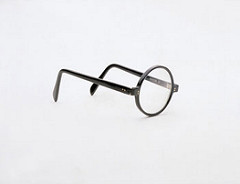Life Imitating Surrealism
By John Schoneboom

Marcel Mariën, "The Untraceable"
In 1958, a Belgian surrealist and public relations professional called Marcel Mariën drew up a tongue-in-cheek political program that would play people for fools and then shock them into revolution by exposing its own trickery. At least, I think it was tongue in cheek; after all, it was published in a surrealist journal: Les lèvres nues. In any case, much of Mariën's surrealist concept of propaganda -- bringing two bastard children of Freud together in one playground -- turns out to resonate uncannily with the world we inhabit today.
Modern propaganda began, it is widely held, with one Edward Bernays, who was also the nephew of Sigmund Freud himself. Bernays drew on his uncle's theories of the unconscious in a purposive way to evoke and manipulate people's desires in a highly instrumentalized fashion. His 1928 book Propaganda described concepts that would be widely employed to sell everything from anti-Communist hysteria to Madame Walker's All-Purpose Hair Conditioning Cream. During the same decade, an ocean away, the Surrealists were going in the opposite direction with the same Freudian inspiration. As Hagen Schölzel argues, while both schools of thought understood the potential of the unconscious to change human behavior, Bernays sought to create order from chaos and the Surrealists sought the reverse: liberation of the chaos of desire from the remorseless constraints of socially imposed order. As a professional public relations specialist and a surrealist artist who was close friends with René Magritte, Marcel Mariën was ideally placed to fuse the two disciplines to pointed effect.
Mariën's program involved the creation of two spurious political parties, the Imaginary Party and the Counter Party. Unknown to all but the masterminds, they would secretly share not only the same goals, but a common physical headquarters. The parties would have two faces: one public and legal, the other secret and illegal. By delivering professional quality rhetoric of the precise sort most deeply desired by a hungry public, the parties would between the two of them secure a parliamentary mandate. The campaign would be built from a foundation of "leisure clubs", nominally staunchly anti-political and non-ideological to cater to the mood of the times. The parties would consciously avoid using normal political language, style, symbols, and rites, in order to "mask" the political nature of the enterprise. From this base a "grassroots" movement would gradually be developed. The secret headquarters, run by a tiny number of elite representatives, would be funded by crime and terrorism. In Mariën's Al Capone-echoing words:
"[T]he single opportunity to procure that money obviously consists in getting it there, where it is. [...] A blade against the throat, the threat of some Asian torture as well as hostage-taking would make each bank manager a precious and entirely compliant auxiliary tool. [...] Employees and customers [...] are not at all prepared to resist the onslaught of machine pistols, hand grenades, teargas or, if necessary, flamethrowers."
The campaigns themselves would be initially sparked by undercover operatives employing word of mouth in casual leisure settings, and then reinforced and amplified by a full multimedia propaganda onslaught designed by marketing professionals. Men of vision and independence, who might engage in unwanted critical thinking, would be identified as quickly as possible and tossed out. Petty inter-party disputes over minor differences would be encouraged as "artificial competition." Any resemblance between Mariën's scenario and the corruption-soaked Republican-Democrat convergence around issues of war, surveillance, and corporatism may be purely coincidental, but it's not the least striking parallel I've ever seen. Ultimately, in Mariën's program, the secret common purpose is revealed, starting with an "accidental" leak about the shared headquarters that quickly unravels the whole operation, providing a psychological shock that stimulates a spontaneous people's revolution. I'm presuming everyone lives happily ever after once that happens.
Schölzel wrestles with whether this sort of surrealist discourse constitutes a form of terrorism, or whether it exceeds its literal bounds as a form of black humor. In light of the fact that the program is obviously quite funny, it may be tempting to dismiss the former possibility out of hand. But strangely enough, no less a personage than Jean Clair, a former director of the Picasso Museum in Paris, wrote a scathing article in November 2001 that quite seriously and unironically blamed Surrealism for the attacks of 9/11. One needn't be quite so literal to see in Surrealism some loosely defined form of terrorism, if only aesthetic, cultural, or psychological. Certainly, they hoped to inspire revolution. This last step in Mariën's program -- the payoff, the people's revolutionary rebuke of mass deception -- is perhaps the one element where life has yet to imitate art. But perhaps it is imitating it in slow motion. As Freudians, propagandists, and surrealists alike know all too well, one always has one's dreams.
References
Bernays, Edward, 1928. Propaganda. New York: H. Liveright.
Clair, Jean, 2001. Surrealism and the demoralization of the West. Le Monde, 22 November 2001.
Mariën, Marcel, 1958. Théorie de la révolution mondiale immédiate [Theory of the Immediate World Revolution]. Les lèvres nues 11/12.
Schölzel, Hagen, 2014. Surrealistic communication as symbolic terrorism: The example of Marcel Mariën's theory of political campaigning. Public Relations Inquiry, Vol 3(2), pp 193-207.


